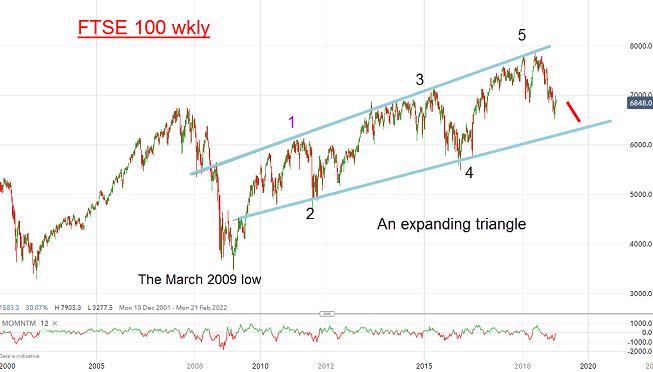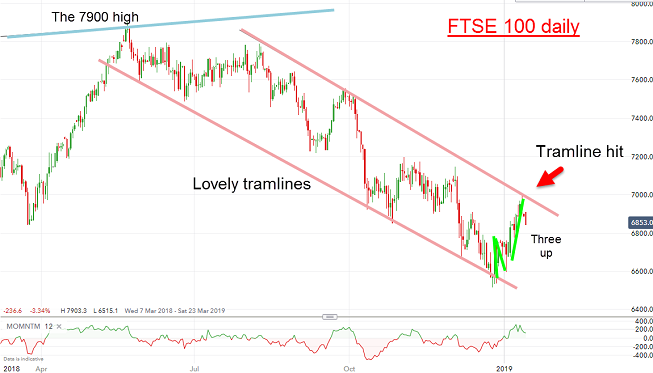Chart of the week: Will 6,900 represent a major high for FTSE 100?
14th January 2019 11:52
by John Burford from interactive investor
Thoughts of imminent collapse have been parked after an impressive rally since December, but are we in a long-term bear trend? Analyst John Burford gives his view.

After the tumultuous December in stockmarkets, I thought I would assess the current position in the FTSE 100 index. The December Dip (or the US Tech Wreck, as some may call it) produced an avalanche of advice in the mainstream media to 'Batten down the hatches', and 'Don't panic', and even 'Buy the Dip'.
But was that wise advice for UK shares? After all, it is the default position of the perma-bulls no matter what headwinds the market is facing (and there are plenty, as always). No, it is far safer to join the herd and stay with the usual buy-and-hold strategy.
But what if we truly are in a genuine bear market where a buy-and-hold policy would be disastrous?
Every so often I like to go back to the long-range charts to see if there is any effective trend working.

Source: interactive investor Past performance is not a guide to future performance
This is the 10-year rally off the 2009 lows and the advance has been hesitant to say the least. One advance after another has been met with savage declines, and there are five clear waves to the recent 7,900 high.
But what is remarkable is that the highs all line up on the upper blue trendline (resistance), while the lows all line up on its trendline (support). And the entire pattern is an expanding triangle – a relatively rare occurrence.
Another remarkable feature is that there are five clear waves to the 7,900 high, which is necessary to consider the pattern complete.
Thus, I have confidence that the 6,900 level will represent a major high and the trend is now down.
To get a handle on the short-term gyrations, here is the daily chart:

Source: interactive investor Past performance is not a guide to future performance
The decline off the 7,900 high has travelled inside the trading channel between my pink tramlines. The lower line is especially strong as support as it possesses multiple very accurate touch points. But note that last week’s rally made an accurate hit on the upper resistance line and is currently bouncing down off it.
And according to my trading rules, that was an ideal point to enter short trades since the main trend is down.
So, what could spoil this bearish picture? Well, a strong push above the upper tramline would certainly delay any thoughts of an imminent collapse, but would not in itself change the long-term bear trend.
Odds are the bear trend remains in place, subject to possible decent counter-trend rallies.
For more information about Tramline Traders, or to take a three-week free trial, go to www.tramlinetraders.com.
John Burford is the author of the definitive text on his trading method, Tramline Trading. He is also a freelance contributor and not a direct employee of interactive investor.
These articles are provided for information purposes only. Occasionally, an opinion about whether to buy or sell a specific investment may be provided by third parties. The content is not intended to be a personal recommendation to buy or sell any financial instrument or product, or to adopt any investment strategy as it is not provided based on an assessment of your investing knowledge and experience, your financial situation or your investment objectives. The value of your investments, and the income derived from them, may go down as well as up. You may not get back all the money that you invest. The investments referred to in this article may not be suitable for all investors, and if in doubt, an investor should seek advice from a qualified investment adviser.
Full performance can be found on the company or index summary page on the interactive investor website. Simply click on the company's or index name highlighted in the article.
Disclosure
We use a combination of fundamental and technical analysis in forming our view as to the valuation and prospects of an investment. Where relevant we have set out those particular matters we think are important in the above article, but further detail can be found here.
Please note that our article on this investment should not be considered to be a regular publication.
Details of all recommendations issued by ii during the previous 12-month period can be found here.
ii adheres to a strict code of conduct. Contributors may hold shares or have other interests in companies included in these portfolios, which could create a conflict of interests. Contributors intending to write about any financial instruments in which they have an interest are required to disclose such interest to ii and in the article itself. ii will at all times consider whether such interest impairs the objectivity of the recommendation.
In addition, individuals involved in the production of investment articles are subject to a personal account dealing restriction, which prevents them from placing a transaction in the specified instrument(s) for a period before and for five working days after such publication. This is to avoid personal interests conflicting with the interests of the recipients of those investment articles.